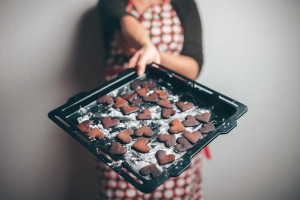There's more to getting good, consistent results from your oven than just setting the time and temperature. Here are 4 surprising things to know about your oven.
Interested in learning more about using your oven? Check out our Oven rack placement for best results video. We also have troubleshooting tips and DIY repair help for ranges and wall ovens. And if you’re looking for accessories–like this oven thermometer–we can help with that too.
Not pre-heating enough
Baked goods such as cakes, pies, cookies and pastries are delicate creatures that demand a consistent temperature for the entire cooking time. And a consistent temperature depends on thorough pre-heating.
Precise pre-heating isn’t critical when you roast meat or vegetables, but when baking, don’t go by the pre-heat beep on your oven. Most ovens need at least 20 to 30 minutes to reach and maintain the temperature you set. Ovens with a hidden bake element take longer than those with an exposed element.
To make sure your oven is completely pre-heated, let the oven elements or burner cycle on and off 2 or 3 times. In an electric oven, during each cycle, the heating element starts then stops glowing red; a gas oven’s burner makes a soft whoosh sound when the burner goes on and again when it turns off.
When you’re satisfied that the preheat temperature has been reached, put the food in the oven as quickly as possible to minimize heat loss. Open the oven as seldom as possible while baking.
Trusting the temperature setting
If food always takes longer or shorter to bake or roast than the recipe says, it could be that the oven temperature you set isn't the oven temperature you actually get. If you suspect your oven temperature is incorrect, place an accurate digital thermometer with remote sensing probe in the middle of the center rack to measure actual oven temperature.
If the temperature is out of whack, recalibrate the oven. This guide gives examples of instructions for ovens with push-button controls and with knob controls. Because instructions vary by manufacturer, check your owner's manual for instructions specific to your model.
Using the wrong bakeware
The material from which bakeware is made influences how well it distributes heat, and thus how quickly foods cook. Manufacturers recommend increasing the cooking time when you use stainless-steel bakeware and insulated cookie sheets or baking pans. Decrease the oven temperature by about 25 degrees for oven-proof glass and ceramic bakeware.
Self-cleaning at the last minute
If you plan to use your oven’s self-cleaning feature before a big get-together, clean it at least a week before the event. That gives you time to fix it if the very high temperatures used for self-cleaning trip one of the oven's safety devices, disabling the oven.
Another infrequent problem is that the door won’t unlock after the oven cools. You might be able to fix it yourself: start a clean cycle, wait 1 minute and then press Cancel. If the door is still locked after 2 minutes, this video shows you how to reset the lock quickly and get the door working again. It also shows you how to tell if the lock motor is broken and replace it if needed.







